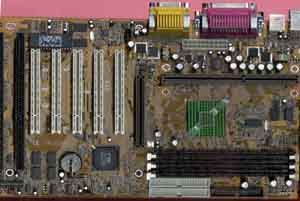ABIT VA6 Apollo Pro 133 Slot-1 ATX
by Anand Lal Shimpi on February 8, 2000 2:11 AM EST- Posted in
- Motherboards
Since 1989 ABIT has been working at separating themselves from the increasingly saturated motherboard market, either by being the first to produce a product like they did in 1993 with the first VLB SCSI Controller at Fall Comdex or by introducing an innovative new feature such as SoftMenu, their jumperless CPU setup utility back in 1996.
Unfortunately for ABIT, the competition in the saturated motherboard manufacturing market has put ABIT in a very difficult position. They can no longer rely on their SoftMenu setup to sell motherboards since virtually all manufacturers now have a jumperless CPU setup utility, AWARD's latest BIOS release even provides for such a utility, it is up to the motherboard manufacturers to take advantage of it.
Because ABIT never really had more than their SoftMenu setup going for their name, they have resorted to producing a very large product line in an attempt to increase their market coverage. In this process of expanding, ABIT has taken a path that they have never journeyed down before. With the lack of practicality behind the i820 chipset because of the incredible cost and low yields on RDRAM, VIA's Apollo Pro 133 and 133A chipsets have become desired solutions for motherboard manufacturers looking to support the latest 133MHz FSB Intel CPUs.
Forced into an unfamiliar position, ABIT hoped to profit off of their well-known name among those in the overclocker community with their first ever motherboard based on a VIA chipset, the VA6. Based on the Apollo Pro 133 with a later revision due out using the Apollo Pro 133A chipset (which adds AGP 4X support) ABIT's VA6 is one of the piles of new motherboards appearing in the market based on the VIA chipset, but just as we've seen in the past from this Taiwanese based company, sometimes their products aren't exactly perfect the first time around.
New Anand Tech Report Card Rating 80/C-
| CPU Interface |
Slot-1
|
| Chipset |
VIA Apollo 133
VIA 693A North Bridge VIA 686A South Bridge |
| L2 Cache |
N/A (on-chip)
|
| Form Factor |
ATX
|
| Bus Speeds |
66 / 75 / 83
100 / 105 / 110 / 112 / 115 / 120 / 124 133 / 140 / 150 |
| Voltages Supported |
1.30v - 3.2v (in 0.05v increments)
|
| Memory Slots |
3 168-pin DIMM Slots
|
| Expansion Slots |
0 AMR Slots
1 AGP Slot 5 PCI Slots (5 Full Length) 2 ISA Slots (1 Shared / 1 Full Length) |
| AC'97 |
VIA VT1611A
|
| BIOS |
AWARD BIOS
|
The Good
The VA6 looks surprisingly enough like ABIT's BH6 from the days of the Celeron 300A overclockers. The resemblance starts with the PCB layout and moves into the actual expansion slot configuration on the board. The VA6 still makes use of the 5/2/1 configuration (PCI/ISA/AGP) and interestingly enough doesn't feature a single AMR slot, a very odd thing since most motherboards that use VIA's 686A South Bridge (which supports the AC'97 and MC'97 codecs) do in fact feature an AMR slot. This helps to support the theory that the VA6 borrows the PCB design from the old BH6.
The VIA 686A South Bridge helps keep the cost of the VA6 down as it integrates hardware monitoring functionality, a PCI-to-ISA bridge and the normal South Bridge functions into a single chip. Because of this high level of integration, ABIT was able to outfit the VA6 with those 2 ISA slots at no added cost other than the cost of the slots themselves. Whether or not the 2 ISA slots are actually useful is up to the individual user to decide (only 1 ISA slot is pictured to the right).
The 686A is also the reason the VA6 does not feature ABIT's on-board HighPoint Ultra ATA 66 controller since the South Bridge features native support for Ultra ATA 66 devices. This is a very welcome change simply because there have been a number of problems reported with the HighPoint controller relating to compatibility with non-Ultra ATA 66 drives among other issues. Basically we were very glad to see the absence of that controller on the VA6 thanks to VIA's 686A South Bridge.
The three memory slots on the VA6 are capable of accepting up to 256MB modules of PC100/PC133 SDRAM or VC100/VC133 Virtual Channel SDRAM courtesy of the Apollo Pro 133 (693A) North Bridge chip located just above the memory banks. In spite of this theoretical support for 256MB modules, our 256MB Corsair modules had difficulty working reliably on the motherboard while they seemed to have no problems on other motherboards.
An interesting point that you may have picked up on is that the VA6 makes use of the older 693A version of VIA's North Bridge, and not the 694X which is commonly known as the Apollo Pro 133A. The only difference between the 693A and the 694X is that the latter features AGP 4X support while the 693A North Bridge is limited to AGP 2X transfers. From an implementation standpoint, the additional pins required for AGP 4X on the 694X North Bridge would force ABIT to adjust the design of the VA6 even more than implementing the 693A would since the latter is essentially pin compatible with the 443BX North Bridge from their BH6 and other BX board designs.
Once again, this supports the theory that ABIT produced the VA6 essentially as a VIA based version of their BX based BH6, an issue which we will get into greater depth with later. ABIT does plan on releasing a 694X based motherboard in the future, but for now the only VIA based solution is the VA6 using the 693A North Bridge.











0 Comments
View All Comments